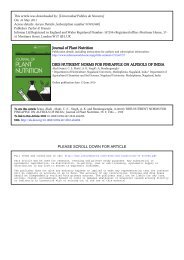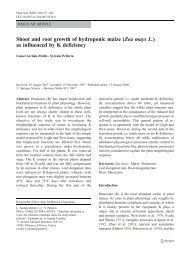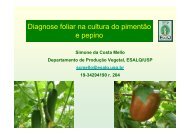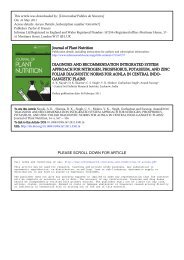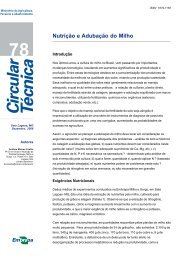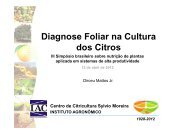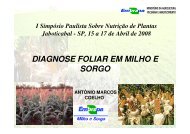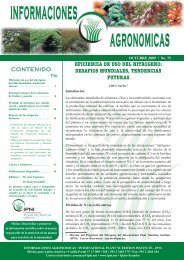Leaf silicon content in banana (Musa spp.) reveals ... - ResearchGate
Leaf silicon content in banana (Musa spp.) reveals ... - ResearchGate
Leaf silicon content in banana (Musa spp.) reveals ... - ResearchGate
Create successful ePaper yourself
Turn your PDF publications into a flip-book with our unique Google optimized e-Paper software.
Plant Soil (2008) 313:71–82<br />
DOI 10.1007/s11104-008-9680-7<br />
REGULAR ARTICLE<br />
<strong>Leaf</strong> <strong>silicon</strong> <strong>content</strong> <strong>in</strong> <strong>banana</strong> (<strong>Musa</strong> <strong>spp</strong>.) <strong>reveals</strong><br />
the weather<strong>in</strong>g stage of volcanic ash soils <strong>in</strong> Guadeloupe<br />
C. Henriet & L. Bodarwé & M. Dorel & X. Draye &<br />
B. Delvaux<br />
Received: 3 March 2008 /Accepted: 4 June 2008 / Published onl<strong>in</strong>e: 26 June 2008<br />
# Spr<strong>in</strong>ger Science + Bus<strong>in</strong>ess Media B.V. 2008<br />
Abstract Several plant species accumulate <strong>silicon</strong>,<br />
which is taken up by roots <strong>in</strong> soil solution. The Si<br />
concentration <strong>in</strong> soil solution can be governed by<br />
silicate dissolution and formation, and thus soil<br />
constitution. Here, we study the Si leaf <strong>content</strong> of<br />
mature <strong>banana</strong> plants (<strong>Musa</strong> acum<strong>in</strong>ata cv Grande<br />
Na<strong>in</strong>e) cropped on soils derived from andesitic ash <strong>in</strong><br />
Guadeloupe through standard foliar analysis. The<br />
soils strongly differ <strong>in</strong> weather<strong>in</strong>g stage and total Si<br />
<strong>content</strong>. The most desilicated soils (Andosol–Nitisol–<br />
Ferralsol) occur <strong>in</strong> the wettest areas, on the Eastern<br />
slopes (Es) of the volcano exposed to ra<strong>in</strong> bear<strong>in</strong>g<br />
w<strong>in</strong>ds. Least weathered soils (Andosol–Cambisol)<br />
occur on Western slopes (Ws). The average leaf Si<br />
concentration ranges from 2.7 to 3.9 g kg −1 for <strong>banana</strong>s<br />
cropped <strong>in</strong> Es soils, and from 7.7 to 9.6 g kg −1 <strong>in</strong> Ws<br />
soils. The leaf Si concentrations are lowest for the Es<br />
gibbsite-rich Andosols and Ferralsols. The leaf Si<br />
concentration is positively correlated with soil CaCl 2 -<br />
extractable Si <strong>content</strong>, soil Si <strong>content</strong> and total reserve<br />
<strong>in</strong> weatherable m<strong>in</strong>erals. The <strong>silicon</strong> <strong>content</strong> of <strong>banana</strong><br />
leaves thus <strong>reveals</strong> the weather<strong>in</strong>g stage of volcanic ash<br />
soils <strong>in</strong> Guadeloupe.<br />
Keywords Silicon . <strong>Musa</strong> . Foliar diagnosis . Soil<br />
weather<strong>in</strong>g . Transpiration<br />
Responsible Editor: Jian Feng Ma.<br />
C. Henriet : L. Bodarwé : B. Delvaux (*)<br />
Soil Science Unit, Université Catholique de Louva<strong>in</strong>,<br />
Place Croix du Sud 2/10,<br />
1348 Louva<strong>in</strong>-la-Neuve, Belgium<br />
e-mail: bruno.delvaux@uclouva<strong>in</strong>.be<br />
M. Dorel<br />
Département des productions fruitières et horticoles,<br />
Centre de coopération <strong>in</strong>ternationale en recherche<br />
agronomique pour le développement (CIRAD),<br />
Station de Neufchâteau,<br />
Capesterre-Belle-Eau, Guadeloupe<br />
X. Draye<br />
Crop Physiology and Plant Breed<strong>in</strong>g Unit,<br />
Université Catholique de Louva<strong>in</strong>,<br />
Place Croix du Sud 2/11,<br />
1348 Louva<strong>in</strong>-la-Neuve, Belgium<br />
Introduction<br />
Silicon plays a crucial role <strong>in</strong> global biogeochemical<br />
processes such as the regulation of carbon dioxide<br />
(Berner 1995; Kump et al. 2000), the buffer<strong>in</strong>g of<br />
proton fluxes through silicate dissolution (Rai and<br />
Kittrick 1989), and the nutrition of both mar<strong>in</strong>e and<br />
terrestrial biota (Smetacek 1999). S<strong>in</strong>ce the rates of<br />
m<strong>in</strong>eral dissolution can be enhanced by plant impact<br />
on silicate weather<strong>in</strong>g (Moulton et al. 2000), plants<br />
can exert a strong impr<strong>in</strong>t on the Si cont<strong>in</strong>ental cycle,<br />
and thereby on Si release to water streams (Derry et<br />
al. 2005). Several plant species readily accumulate<br />
<strong>silicon</strong>, which is, however, not considered as an<br />
essential plant nutrient (Epste<strong>in</strong> 1994). Si-accumulators<br />
are mostly monocots (Ma and Takahashi 2002).
72 Plant Soil (2008) 313:71–82<br />
Silicon is taken up by plant roots <strong>in</strong> the form of watersoluble<br />
H 4 SiO 4 and follows the water flow from roots<br />
to transpiration sites (Raven 2001) through passive and<br />
active transport (Ma et al. 2006). There<strong>in</strong>, silica precipitates<br />
with<strong>in</strong> particles of biogenic opal (SiO 2·nH 2 O),<br />
called phytoliths (Smithson 1956). In controlled conditions,<br />
the supply of H 4 SiO 4 <strong>in</strong> the nutrient solution<br />
governs the <strong>content</strong> of Si <strong>in</strong> plant tissue (Van der Vorm<br />
1980; Henriet et al. 2006).<br />
Silicon soil-to-plant transfer could thus be <strong>in</strong>fluenced<br />
by the availability of aqueous H 4 SiO 4 <strong>in</strong> soil, and by the<br />
plant transpiration rate. The concentration of H 4 SiO 4 <strong>in</strong><br />
soil solution may range between 0.01 and 1.99 mM<br />
(Karathanasis 2002). It varies depend<strong>in</strong>g on Si plant<br />
uptake, adsorption onto Fe- and Al-oxides, silicate<br />
weather<strong>in</strong>g and dissolution, and silicate formation<br />
(Sommer et al. 2006). The m<strong>in</strong>eralogical constitution<br />
of soils may thus control the concentration levels of<br />
H 4 SiO 4 <strong>in</strong> the soil solution (Kittrick 1969; Karathanasis<br />
2002). In humid tropical regions, desilication is a major<br />
trait of weather<strong>in</strong>g (Chadwick et al. 2003). In these<br />
areas, weather<strong>in</strong>g sequences of soils developed on<br />
volcanic ash are remarkably suited to study the impact<br />
of soil weather<strong>in</strong>g stage on soil constitution and<br />
properties (Parfitt et al. 1983; Delvaux et al. 1989;<br />
Chadwick et al. 2003), on plant nutrient status<br />
(Delvaux et al. 1989; Chadwick et al. 1999), and likely<br />
on plant Si concentration (Fox et al. 1967).<br />
Silicon accumulation by young <strong>banana</strong> plantlets<br />
(<strong>Musa</strong> acum<strong>in</strong>ata cv Grande Na<strong>in</strong>e) <strong>in</strong> hydroponics is<br />
controlled by the concentration of Si <strong>in</strong> the nutrient<br />
solution (Henriet et al. 2006). Here, we assess the<br />
<strong>silicon</strong> status of mature <strong>banana</strong> plants cropped on soils<br />
developed on andesitic ash, but differ<strong>in</strong>g <strong>in</strong> their weather<strong>in</strong>g<br />
stage and m<strong>in</strong>eralogical constitution (Colmet-<br />
Daage and Gautheyrou 1974; Ndayiragije 1996;<br />
Ndayiragije and Delvaux 2004). We further evaluate<br />
the availability of Si for plants <strong>in</strong> these soils, and <strong>in</strong>fer its<br />
dependence on soil constitution and weather<strong>in</strong>g stage.<br />
Environmental framework<br />
In the island of Basse-Terre, Guadeloupe (16° N, 61° W),<br />
Caribbean area, volcanic ash soils cover extensive<br />
areas on the surround<strong>in</strong>g slopes of the active volcano<br />
La Soufrière (1,467 m asl), and of eroded ancient<br />
volcanoes active dur<strong>in</strong>g Tertiary times (Colmet-Daage<br />
and Lagache 1965). The ash deposits of Quaternary<br />
and Pliocene times are of andesitic composition;<br />
plagioclase, pyroxene and ferromagnesian volcanic<br />
glasses are the dom<strong>in</strong>ant weatherable m<strong>in</strong>erals (Daga<strong>in</strong><br />
et al. 1981; Ndayiragije 1996). The ashy materials<br />
readily weathered under humid tropical conditions.<br />
On the Western slopes (Ws) of the volcano, the Ws soil<br />
pattern <strong>in</strong>volves an Andosol–Cambisol–Vertisol toposequence<br />
from 500 m asl to sea level, correspond<strong>in</strong>g to<br />
mean annual ra<strong>in</strong>fall (MAR) decreas<strong>in</strong>g from ∼3,500 to<br />
∼1,000 mm (Fig. 1), and to the m<strong>in</strong>eralogical sequence<br />
ash → allophane → halloysite/smectite → smectite<br />
(Colmet-Daage and Lagache 1965; P<strong>in</strong>eros Garcet<br />
1994). The Eastern slopes (Es) of the volcano are<br />
exposed to ra<strong>in</strong>-bear<strong>in</strong>g w<strong>in</strong>ds from the Atlantic<br />
Ocean: MAR exceeds 5,000 mm at 500 m asl, and<br />
decreases to 2,500 mm downslope at sea level (Fig. 1).<br />
The Es soil pattern <strong>in</strong>volves an Andosol–Nitisol–<br />
Ferralsol weather<strong>in</strong>g sequence, correspond<strong>in</strong>g to the<br />
m<strong>in</strong>eralogical sequence ash → gibbsite, allophane →<br />
halloysite, Fe-oxide → kaol<strong>in</strong>ite, Fe-oxide, gibbsite<br />
(Colmet-Daage and Lagache 1965; Ndayiragije 1996;<br />
Ndayiragije and Delvaux 2003, 2004). Ws Andosols<br />
and Cambisols as well as Es Andosols, Nitisols and<br />
Ferralsols have long been extensively used for <strong>in</strong>tensive<br />
<strong>banana</strong> cropp<strong>in</strong>g (Colmet-Daage and Lagache<br />
1965; Ndayiragije 1996; Dorel et al. 2000). The soils<br />
are thus fertilized, notably by K, Ca, and Mg supplies.<br />
Materials and methods<br />
Experimental sites and general sampl<strong>in</strong>g scheme<br />
Six experimental sites were selected on the basis of<br />
the detailed 1:20,000 soil map of Guadeloupe<br />
(Colmet-Daage 1969; Fig. 1). Their ma<strong>in</strong> characteristics<br />
are presented <strong>in</strong> Table 1. Two sites corresponded<br />
to the Ws Andosols (Ws-An) and Cambisols (Ws-Ca),<br />
and four sites to the Es perhydrated Andosols (Es-<br />
An1), Andosols (An2), Nitisols (Es-Ni), and Ferralsols<br />
(Es-Fe). The Ferralsols (Es-Fe) developed from Tertiary<br />
pyroclasts deposited dur<strong>in</strong>g Pliocen (Daga<strong>in</strong> et al.<br />
1981). The other soils developed from Quaternary ash<br />
deposits (4,000–140,000 years BP) (Colmet-Daage<br />
and Gautheyrou 1974; Daga<strong>in</strong> et al. 1981). They are<br />
members of chronotoposequences characterized by<br />
decreas<strong>in</strong>g elevation and decreas<strong>in</strong>g MAR <strong>in</strong> the<br />
order Ws-An–Ws-Ca on western slopes, and Es-<br />
An1–Es-An2–Es-Ni on eastern slopes (Fig. 1).
Plant Soil (2008) 313:71–82 73<br />
Fig. 1 Mean annual ra<strong>in</strong>fall<br />
(mm) map of the island<br />
Basse-Terre (Guadeloupe)<br />
(Chaperon et al. 1985).<br />
Circles <strong>in</strong>dicate the localization<br />
of the experimental<br />
sites on each major soil<br />
type: Andosol, Cambisol,<br />
Nitisol, Ferralsol, of the<br />
Western and the Eastern<br />
slopes of the volcano La<br />
Soufrière<br />
Western slope<br />
Andosols<br />
Cambisols<br />
Eastern slope<br />
Perhydrated Andosols<br />
Andosols<br />
Nitisols<br />
Ferralsols<br />
In each experimental site, we selected ten cultivated<br />
<strong>banana</strong> plots. The cultivar was <strong>Musa</strong> acum<strong>in</strong>ata cv<br />
Grande Na<strong>in</strong>e (group AAA, Cavendish, dessert <strong>banana</strong>).<br />
In each plot, we selected ten plants of similar<br />
crop yield potential, i.e. homogeneous pseudostem<br />
circumference (∼65–70 cm as measured for each plant<br />
at 1 m from soil surface), at flower<strong>in</strong>g. For each plant,<br />
we sampled the external part of the lam<strong>in</strong>a at the centre<br />
(100 mm width) of the antepenultimate leaf (leaf III),<br />
follow<strong>in</strong>g the <strong>in</strong>ternational standard set up for <strong>banana</strong><br />
foliar diagnosis (Mart<strong>in</strong>-Prével 1980). The ten foliar<br />
samples were mixed up as a composite leaf sample for<br />
Table 1 Some characteristics of the six experimental sites correspond<strong>in</strong>g to the Western (Ws) and Eastern (Es) slopes of the volcano<br />
La Soufrière<br />
Symbol<br />
Soil type (WRB:<br />
ISSS 1998)<br />
Locality Elevation a (m asl) Ra<strong>in</strong>fall b (mm) Clay m<strong>in</strong>erals c<br />
Ws-An Humic Andosol Grand-Val 471 3,448 Allophane<br />
Ws-Ca Haplic Cambisol Belle-Vue 202 1,808 Halloysite, smectite<br />
Es-An1 Molli-silicic Andosol Féfé 412 4,697 Gibbsite, allophane, kaol<strong>in</strong>ite, hydroxy-Al<br />
<strong>in</strong>terlayered 2:1 m<strong>in</strong>erals<br />
Es-An2 Humic Andosol Neufchâteau 226 3,645 Allophane, gibbsite, hydroxy-Al <strong>in</strong>terlayered<br />
2:1 m<strong>in</strong>erals<br />
Es-Ni Haplic Nitisol Changy 35 2,566 Halloysite, Fe oxide<br />
Es-Fe Haplic Ferralsol Féneteau 162 3,284 Kaol<strong>in</strong>ite, Fe oxide, gibbsite<br />
a Average value of the sampl<strong>in</strong>g area<br />
b Mean annual ra<strong>in</strong>fall (Chaperon et al. 1985)<br />
c Colmet-Daage and Lagache (1965); Colmet-Daage and Gautheyrou (1974); P<strong>in</strong>eros Garcet (1994); Ndayiragije (1996); Ndayiragije<br />
and Delvaux (2003, 2004)
74 Plant Soil (2008) 313:71–82<br />
each plot. We sampled the soil at 50 cm distance from<br />
thebaseofeachoftheten<strong>banana</strong>plantsselectedfor<br />
foliar sampl<strong>in</strong>g, by us<strong>in</strong>g a small auger calibrated at<br />
00–20 cm depth. For each plot, the ten soil samples<br />
were mixed up as a composite bulk sample. The<br />
comprehensive sampl<strong>in</strong>g scheme thus <strong>in</strong>volved 600<br />
<strong>in</strong>dividual leaf and soil samples, lead<strong>in</strong>g to 60<br />
composite plant and soil samples for further analyses.<br />
The topsoil-foliar sampl<strong>in</strong>g was carried out between<br />
February and March 2006, after the period of<br />
plant growth dur<strong>in</strong>g the ra<strong>in</strong>y season (April to<br />
January). The coord<strong>in</strong>ates and altitude levels were<br />
recorded at each plot with a global position<strong>in</strong>g system<br />
(Garm<strong>in</strong>®). The altitude levels were used to compute<br />
the mean annual ra<strong>in</strong>fall (MAR) values for each plot<br />
accord<strong>in</strong>g to the l<strong>in</strong>ear regressions established by<br />
Chaperon et al. (1985) for both the Western (Ws) and<br />
Eastern (Es) slopes of the volcano:<br />
Ws :<br />
MARðmm<br />
r 2 ¼ 0:97<br />
Es : MARðmm<br />
r 2 ¼ 0:94<br />
Plant material and analysis<br />
Þ ¼ 577 þ 6:10 ðElevationðmÞÞ<br />
Þ ¼ 2; 368 þ 5:65 ðElevationðmÞÞ<br />
The 60 composite leaf samples were stored at 60°C<br />
for 1 week for dry weight determ<strong>in</strong>ation. M<strong>in</strong>eral<br />
analysis was carried out after calc<strong>in</strong>ation at 450°C for<br />
1 day and fusion <strong>in</strong> Li-metaborate + Li-tetraborate at<br />
1,000°C (Chao and Sanzolone 1992), followed by ash<br />
dissolution with concentrated HNO 3 . Nutrient and Si<br />
concentrations were measured by <strong>in</strong>ductively coupled<br />
plasma-atomic emission spectrometry (ICP-AES).<br />
S<strong>in</strong>ce the Si concentration shows a strong gradient<br />
between young and old leaves (Henriet et al. 2006),<br />
the foliar concentration of Si was also measured from<br />
leaf I to the oldest leaf. For this purpose, we selected a<br />
representative <strong>banana</strong> plot for each site, where soil<br />
conditions were close to the central concept of each<br />
site-specific soil. In each of these plots, we selected<br />
one <strong>banana</strong> plant among the ten selected for foliar<br />
diagnosis. The chosen plant had a pseudostem<br />
circumference closest to the average value at the plot<br />
level. For each plant, we sampled <strong>banana</strong> leaves from<br />
leaf I to the oldest leaf. All the procedure was then<br />
similar to the one described here above up to the<br />
determ<strong>in</strong>ation of leaf Si concentration.<br />
Soil material and analysis<br />
The 60 bulk soil samples were moderately air-dried (12 h<br />
at room temperature, 20°C), sieved at 2 mm, and stored<br />
for further analyses. Sub-samples were dried at 105°C<br />
until constant weight to determ<strong>in</strong>e soil dry weight.<br />
The CaCl 2 -extractable Si <strong>content</strong> was determ<strong>in</strong>ed<br />
<strong>in</strong> each bulk sample us<strong>in</strong>g 0.01 M CaCl 2 (adapted<br />
from Haysom and Chapman 1975). The extraction<br />
procedure was standardized as follows: a 5-g (equivalent<br />
dry weight) soil sample was placed <strong>in</strong>to a<br />
100 ml polyethylene cup with 50 ml extractant (soil/<br />
solution ratio 1:10) and shaken for 5 h at 20°C. The<br />
suspensions were then centrifuged at 3,400×g for<br />
10 m<strong>in</strong>, and the supernatants were filtered through<br />
Whatman no. 4 paper. The concentration of Si <strong>in</strong> the<br />
supernatant was determ<strong>in</strong>ed by ICP-AES. The measurement<br />
of soil CaCl 2 -extractable Si <strong>content</strong> was<br />
done twice. Soil pH was measured <strong>in</strong> H 2 O <strong>in</strong><br />
5 g:25 ml suspensions. Cation exchange capacity<br />
(CEC) and the <strong>content</strong> of exchangeable cations were<br />
determ<strong>in</strong>ed accord<strong>in</strong>g to Jackson (1965). Elemental<br />
analysis was carried out for the 60 soil samples after<br />
calc<strong>in</strong>ation at 1,000°C and Li-metaborate + Litetraborate<br />
fusion (Chao and Sanzolone 1992). Briefly,<br />
a crushed sample of 100 mg was melted at 1,000°C<br />
for 5 m<strong>in</strong> <strong>in</strong> a graphite crucible <strong>in</strong> the presence of 0.4 g<br />
Li-tetraborate and 1.6 g Li-metaborate. The cooled<br />
melt was then dissolved <strong>in</strong> 100 ml of 2 M HNO 3 under<br />
magnetic agitation at 100°C. The <strong>content</strong>s of elements<br />
(Si, Al, Fe, Ca, Mg, K, Na, Ti, and Mn) were<br />
determ<strong>in</strong>ed by ICP-AES spectrometry. The total<br />
<strong>content</strong>s of alkal<strong>in</strong>e and alkal<strong>in</strong>e-earth cations were<br />
summed up as the total reserve <strong>in</strong> bases (TRB), which<br />
estimates the <strong>content</strong> of weatherable m<strong>in</strong>erals <strong>in</strong><br />
m<strong>in</strong>eral soil horizons (Herbillon 1986).<br />
Results<br />
Soil properties<br />
As illustrated <strong>in</strong> Table 2, the average pH values <strong>in</strong><br />
each experimental site ranged between 5.1 and 6.0,
Plant Soil (2008) 313:71–82 75<br />
denot<strong>in</strong>g regular lim<strong>in</strong>g under <strong>in</strong>tensive <strong>banana</strong><br />
cropp<strong>in</strong>g (Ndayiragije 1996; Ndayiragije and Delvaux<br />
2004). The average value of CEC significantly<br />
decreased from 57 to 22 cmol c kg −1 <strong>in</strong> the order Es-<br />
An1 > Es-An2 > Ws-An > Es-Ni > Ws-Ca = Es-Fe.<br />
The average <strong>content</strong>s of exchangeable Ca, Mg and K are<br />
relatively large, denot<strong>in</strong>g the regular lim<strong>in</strong>g and fertilization<br />
practices <strong>in</strong> <strong>in</strong>tensive <strong>banana</strong> cropp<strong>in</strong>g systems.<br />
The exchangeable Mg <strong>content</strong> was, however, significantly<br />
larger <strong>in</strong> Ws- than <strong>in</strong> Es-soils. The average value<br />
of ECEC decreased from 14.1 cmol c kg −1 <strong>in</strong> Ws-Ca to<br />
7.8 cmol c kg −1 <strong>in</strong> Es-Fe. The exchange complex was<br />
desaturated <strong>in</strong> all soils except <strong>in</strong> the Cambisols Ws-Ca,<br />
where the average base saturation amounted to 63%.<br />
The CaCl 2 -extractable Si <strong>content</strong> <strong>in</strong> soils (mg kg −1 )<br />
varied from 8 <strong>in</strong> Es-An2 to 69 <strong>in</strong> Ws-Ca (data not<br />
shown). As shown <strong>in</strong> Table 2, the average CaCl 2 -<br />
extractable Si <strong>content</strong> <strong>in</strong> soils significantly decreased<br />
from 54.3 to 18.7 mg kg −1 <strong>in</strong> the sequence Ws-Ca ><br />
Ws-An = Es-Ni > Es-Fe = Es-An1 = Es-An2, the<br />
largest values be<strong>in</strong>g measured <strong>in</strong> Ws-soils.<br />
The TRB values decreased from 341 cmol c kg −1 <strong>in</strong><br />
Ws-Ca (Cambisol) to 21 cmol c kg −1 <strong>in</strong> Es-Fe<br />
(Ferralsol) (data not shown). The total Si <strong>content</strong> <strong>in</strong><br />
soils decreased from 269 g kg −1 <strong>in</strong> Ws-Ca (Cambisol)<br />
to 144 g kg −1 <strong>in</strong> the Es Andosols Es-An1 (data not<br />
shown). The average values of TRB and soil<br />
elemental <strong>content</strong>s <strong>in</strong> each experimental site are<br />
presented <strong>in</strong> Table 3. The average total Mg, Ca, K<br />
and Na <strong>content</strong>s were larger <strong>in</strong> Ws than <strong>in</strong> most Es soils.<br />
The total reserve <strong>in</strong> bases (TRB) sums up the elemental<br />
<strong>content</strong>s of alkal<strong>in</strong>e and alkal<strong>in</strong>e-earth cations, <strong>in</strong>clud<strong>in</strong>g<br />
the cations occluded <strong>in</strong> m<strong>in</strong>erals as well as those located<br />
on ion exchange sites. In this respect, TRB estimates the<br />
<strong>content</strong> of weatherable m<strong>in</strong>erals <strong>in</strong> m<strong>in</strong>eral soil horizons<br />
(Herbillon 1986). The average TRB significantly<br />
decreased from 270 to 26 cmol c kg −1 <strong>in</strong> the order<br />
Ws-Ca > Ws-An > Es-An1 > Es-An2 = Es-Ni > Es-Fe.<br />
Ca and Mg were the major cations <strong>in</strong> the TRB, but<br />
their proportion largely decreased <strong>in</strong> the strongly<br />
weathered Andosols, Nitisols and Ferralsols from the<br />
Eastern slopes (Es-An2, Es-Ni, Es-Fe). The average<br />
total Si <strong>content</strong> was significantly larger <strong>in</strong> Ws (241–<br />
262 g kg −1 ) than <strong>in</strong> Es soils (158–193 g kg −1 ). The<br />
lowest average Si <strong>content</strong>s (159–158gkg −1 )occurred<br />
<strong>in</strong> the Andosols Es-An1 and Es-An2. The largest<br />
average Al, Fe, and Ti <strong>content</strong>s occurred <strong>in</strong> Es soils<br />
(104–137 g kg −1 for Al, 85–111 g kg −1 for Fe, and<br />
6.6–9.4gkg −1 for Ti), and the lowest <strong>in</strong> Ws soils (∼90<br />
for Al, ∼70 g kg −1 for Fe, and ∼5.3gkg −1 for Ti). The<br />
average Mn <strong>content</strong> was larger <strong>in</strong> Es-Ni (3.1 g kg −1 )<br />
and Es-Fe (3.4 g kg −1 ) than <strong>in</strong> any other soils.<br />
<strong>Leaf</strong> Si and nutrient concentrations<br />
The Si concentration <strong>in</strong> <strong>banana</strong> leaf samples (g kg −1<br />
DM) varied from 1.7 <strong>in</strong> the Ferralsol Es-Fe to 12.0 <strong>in</strong><br />
the Cambisol Ws-Ca (data not shown). As shown <strong>in</strong><br />
Table 4, the average leaf Si concentrations per experimental<br />
site ranged between 2.73 to 9.64 g kg −1 DM,<br />
respectively <strong>in</strong> Es-Fe (Ferralsol) and Ws-Ca (Cambisol)<br />
samples. The average leaf Si concentrations were<br />
Table 2 Average values of CaCl 2 -extractable Si <strong>content</strong>, pH, exchangeable bases levels, cation exchange capacity (CEC) and<br />
effective CEC, as measured <strong>in</strong> the f<strong>in</strong>e earth (
76 Plant Soil (2008) 313:71–82<br />
Table 3 Average <strong>content</strong>s of elements, and total reserve <strong>in</strong> Ca, Mg, Na, K (TRB) <strong>in</strong> the f<strong>in</strong>e earth (
Plant Soil (2008) 313:71–82 77<br />
, Ws-An ; , Ws-Ca<br />
o, Es-An1 ; ◊ , Es-An2 ; Δ, Es-Ni ; , Es-Fe<br />
Fig. 2 Relationship between the leaf Si concentration <strong>in</strong><br />
<strong>banana</strong> (external part of the lam<strong>in</strong>a) and the leaf position<br />
related to the sequence of leaf emergence (each po<strong>in</strong>t of the<br />
graph corresponds to one leaf sample)<br />
precipitation and age of parent material. S<strong>in</strong>ce weather<strong>in</strong>g<br />
depletes primary m<strong>in</strong>erals, elements are lost to<br />
leach<strong>in</strong>g. Figure 3 shows that the loss of Si and TRB<br />
(Ca, Mg, K, Na) parallels a relative concentration of<br />
Al and Fe, confirm<strong>in</strong>g previous data obta<strong>in</strong>ed <strong>in</strong><br />
various tropical volcanic environments (Delvaux et al.<br />
1989; Nieuwenhuyse et al. 1994; Chadwick et al.<br />
2003; Delfosse et al. 2005). In our soils developed on<br />
similar andesitic ash, the concomitant decrease of the<br />
total Si <strong>content</strong> and TRB (r=0.74) <strong>reveals</strong> the<br />
advanced weather<strong>in</strong>g stage of the Es soils relatively<br />
to Ws (Table 3, Fig. 3). The loss of Si and base<br />
cations (TRB) results <strong>in</strong> a relative accumulation of Al<br />
and Fe (r=−0.87 and r=−0.86, respectively). It also<br />
<strong>in</strong>duces a relative accumulation of titanium (Fig. 4), a<br />
poorly mobile element <strong>in</strong> soils: Ti <strong>content</strong> is negatively<br />
correlated with Si <strong>content</strong> (r=−0.55) and TRB<br />
(r=−0.83). Table 3, Figs. 3 and 4 all illustrate that Essoils<br />
are more weathered than Ws-soils. The lowest<br />
TRB values (21–32 cmol c kg −1 ) measured <strong>in</strong> Es-Fe<br />
are typical for strongly weathered ferrallitic soils<br />
(Herbillon 1986). Ra<strong>in</strong>fall and the amount of water<br />
available to leach elements from soil are major<br />
features determ<strong>in</strong><strong>in</strong>g weather<strong>in</strong>g, soil constitution<br />
and exchange properties (Chadwick et al. 2003).<br />
Figure 5a illustrates the negative impact of the<br />
amount of annual precipitation on Si <strong>content</strong> of soils<br />
(r=−0.69). Yet, Ws-An and Ws-Ca do not follow the<br />
general trend observed for Es-soils, as they exhibit<br />
larger soil Si <strong>content</strong>s than Es-soils at given MAR<br />
value. These features are caused by less advanced<br />
weather<strong>in</strong>g (see TRB <strong>in</strong> Table 3; Fig. 4) and the<br />
nature of dom<strong>in</strong>ant secondary clay m<strong>in</strong>erals denot<strong>in</strong>g<br />
the presence of smectite <strong>in</strong> Ws-Ca (Table 1), the<br />
stability of which is l<strong>in</strong>ked to relatively high<br />
concentration of aqueous H 4 SiO 4 (Karathanasis<br />
2002). In Es-soils, <strong>in</strong>tense weather<strong>in</strong>g and leach<strong>in</strong>g<br />
led to stronger m<strong>in</strong>eral depletion and desilication<br />
(Table 3, Figs. 4 and 5), and to the synthesis of<br />
secondary oxides and 1:1 clay m<strong>in</strong>erals typical for<br />
such conditions (Table 1). Noteworthy is the fact that<br />
gibbsite is a dom<strong>in</strong>ant secondary constituent <strong>in</strong> the<br />
Es-Andosols (Table 1; Ndayiragije and Delvaux<br />
2003). The l<strong>in</strong>ear decl<strong>in</strong>e of base saturation with<br />
respect to MAR (r=−0.74; Fig. 5b) further illustrates<br />
the depletion of exchangeable cations <strong>in</strong> strong<br />
leach<strong>in</strong>g conditions, despite of regular fertilization as<br />
practiced <strong>in</strong> <strong>in</strong>tensive <strong>banana</strong> cropp<strong>in</strong>g systems.<br />
-◊ Si<br />
•-oAl<br />
▲-ΔFe<br />
Closed symbols: Ws soils<br />
Open symbols: Es soils<br />
Fig. 3 Relationship between total Si, Al, Fe <strong>content</strong>s and total<br />
reserve <strong>in</strong> bases (TRB) <strong>in</strong> the 60 soil samples from the six<br />
experimental sites. Ws Western slopes, Es Eastern slopes
78 Plant Soil (2008) 313:71–82<br />
Fig. 4 Relationship between<br />
soil Ti <strong>content</strong> and:<br />
a total Si <strong>content</strong>, b total<br />
reserve <strong>in</strong> bases (TRB) <strong>in</strong><br />
the 60 soil samples from the<br />
six experimental sites. Ws<br />
Western slopes, Es Eastern<br />
slopes<br />
, Ws-An ; ▲ , Ws-Ca<br />
o, Es-An1 ; ◊ , Es-An2 ; Δ, Es-Ni ; , Es-Fe<br />
<strong>Leaf</strong> <strong>silicon</strong> concentration of <strong>banana</strong> plant <strong>reveals</strong><br />
the weather<strong>in</strong>g stage of soils<br />
To the best of our knowledge, we report here the first<br />
values of leaf concentrations of <strong>silicon</strong> <strong>in</strong> mature <strong>banana</strong><br />
plants, purposely sampled at flower<strong>in</strong>g stage for foliar<br />
diagnosis us<strong>in</strong>g <strong>in</strong>ternational standards (Mart<strong>in</strong>-Prével<br />
1980). The <strong>banana</strong> plant is a <strong>silicon</strong>-accumulator<br />
(Henriet et al. 2006). The average leaf Si concentrations<br />
(Table 4: 2.73–9.64 g kg −1 ) are with<strong>in</strong> the<br />
range of leaf Si concentrations measured <strong>in</strong> young<br />
<strong>banana</strong> plantlets (0–14 g kg −1 ) cultivated <strong>in</strong> hydroponics(Henrietetal.2006).<br />
The average leaf Si concentrations<br />
<strong>in</strong> mature <strong>banana</strong> plants are below the leaf Si<br />
concentrations of other Si-accumulators such as rice<br />
(Oryza sativa) (63gkg −1 DM) and wheat (Triticum<br />
aestivum L.) (14.4 g kg −1 DM) (Ma and Takahashi<br />
2002, and references there<strong>in</strong>). They are, however,<br />
similar to those measured <strong>in</strong> sugarcane (Saccharum<br />
offic<strong>in</strong>arum L.) (7.7 g kg −1 DM), another well-known<br />
Si accumulator (Ma and Takahashi 2002).<br />
The leaf Si concentration <strong>in</strong> <strong>banana</strong> is strongly correlated<br />
with soil CaCl 2 -extractable Si <strong>content</strong> (r=0.85),<br />
total Si <strong>content</strong> (r=0.85), and TRB (r=0.82) (Fig. 6).<br />
The CaCl 2 -extractable Si <strong>content</strong> is directly related to<br />
the concentration of Si <strong>in</strong> soil solution, and thus<br />
provides a convenient test to predict the availability of<br />
soil Si for plants, as shown for different plant species<br />
cropped <strong>in</strong> other soil types (Haysom and Chapman<br />
1975; Chapman et al. 1981; Berthelsenetal.2001).<br />
Figure 6a supports this assessment. In hydroponics, Si<br />
status of young <strong>banana</strong> plantlets is controlled by the<br />
concentration of Si <strong>in</strong> the nutrient solution (Henriet et<br />
al. 2006). The present data corroborate this conclusion<br />
for mature <strong>banana</strong> plants sampled <strong>in</strong> cultivated plots,<br />
s<strong>in</strong>ce the CaCl 2 extractant is recognised to provide a<br />
measure of readily available Si (Chapman et al. 1981).<br />
Figure 6 further shows that the bioavailability of<br />
<strong>silicon</strong>, as measured by the leaf Si concentration of<br />
mature <strong>banana</strong> plants, strongly differs between Ws and<br />
Es-soils, and is directly related to silicate reserve and<br />
soil weather<strong>in</strong>g stage. The leaf Si concentration as well<br />
as the CaCl 2 -extractable Si <strong>content</strong>, soil Si <strong>content</strong> and<br />
TRB all decrease <strong>in</strong> the sequence Ws-Ca > Ws-An ><br />
Es-Ni > Es-Fe = Es-An2 = Es-An1. The bioavailability<br />
of <strong>silicon</strong> is the lowest <strong>in</strong> the Es gibbsitic perhydrated<br />
Andosols and <strong>in</strong> the Ferralsols, where it is l<strong>in</strong>ked to Si<br />
depletion (Fig. 6), and to the relative accumulation of<br />
secondary oxides and Si-poor alum<strong>in</strong>osilicates (Fig. 3,<br />
Table 1). Our experimental data thus suggest that Si<br />
concentration <strong>in</strong> the soil solution may control the<br />
uptake of <strong>silicon</strong> by <strong>banana</strong> plants and thus impact the<br />
leaf Si concentration. In turn, the concentration of<br />
aqueous Si <strong>in</strong> soil is controlled by soil m<strong>in</strong>eral<br />
constitution (Kittrick 1969; Karathanasis 2002). The<br />
dissolution of weatherable m<strong>in</strong>erals is probably a major
Plant Soil (2008) 313:71–82 79<br />
, Ws-An; ▲, Ws-Ca<br />
o, Es-An1 ; ◊ , Es-An2 ; Δ,Es-Ni ; , Es-Fe<br />
Fig. 5 Relationship between a total Si <strong>content</strong> and b base<br />
saturation <strong>in</strong> the 60 soil samples from the six experimental sites<br />
and mean annual ra<strong>in</strong>fall, as computed accord<strong>in</strong>g to Chaperon<br />
et al. (1985) for each plot<br />
process promot<strong>in</strong>g the soil-to-plant transfer of <strong>silicon</strong>.<br />
Bananas are very high nutrient-demand<strong>in</strong>g plants<br />
characterized by exceptional requirements of potassium<br />
(Lahav 1995). The excess of cation over anion uptake<br />
promotes a large excretion of protons by <strong>banana</strong> roots<br />
(Rufyikiri et al. 2001), and thereby a dissolution of<br />
weatherable m<strong>in</strong>erals (H<strong>in</strong>s<strong>in</strong>ger et al. 2001; Rufyikiri<br />
et al. 2004). In our case study, the <strong>silicon</strong> <strong>content</strong> of<br />
mature <strong>banana</strong> leaves is therefore l<strong>in</strong>ked to soil<br />
constitution and weather<strong>in</strong>g stage, <strong>in</strong> turn depend<strong>in</strong>g<br />
on MAR and age of parent material, as discussed<br />
above.<br />
The large proportions of Ca and Mg <strong>in</strong> the TRB of<br />
the least weathered soils (Table 3) are l<strong>in</strong>ked to the<br />
composition of the parent ash, dom<strong>in</strong>ated by plagioclase,<br />
pyroxene and ferromagnesian glass (Daga<strong>in</strong> et<br />
al. 1981; Ndayiragije 1996). The strong and positive<br />
correlation between the leaf Si concentration and the<br />
<strong>content</strong> of non-exchangeable Ca and Na <strong>in</strong> soils (r=<br />
0.88; Fig. 7a) suggests that Ca and Na volcanic<br />
glasses and possibly plagioclase (H<strong>in</strong>s<strong>in</strong>ger et al.<br />
2001) may contribute to the pool of plant-available Si.<br />
The weaker correlation between the leaf <strong>content</strong> of Si<br />
and the <strong>content</strong> of non-exchangeable Mg (r=0.56;<br />
Fig. 7b) suggests that part of silicate Mg may not<br />
readily contribute to that pool. Contents of nonexchangeable<br />
Mg above 50 cmol c kg −1 are related to<br />
Si leaf concentrations generally above 6 g kg −1 <strong>in</strong> Ws<br />
soils, but below 4.5 g kg −1 <strong>in</strong> the Es Andosols Es-An1<br />
and Es-An2. The relatively low contribution of Mg<br />
bear<strong>in</strong>g silicates to the pool of plant-available Si <strong>in</strong> the<br />
Es Andosols may be due to the comb<strong>in</strong>ation of two<br />
factors: the coat<strong>in</strong>g of weathered particles of ferromagnesian<br />
m<strong>in</strong>erals by secondary m<strong>in</strong>erals, as shown<br />
by micromorphological <strong>in</strong>vestigations (Ndayiragije<br />
1996), and the occurrence of hydroxy-Al-<strong>in</strong>terlayered<br />
2:1 clay m<strong>in</strong>erals (Table 1). Oxide and clay coat<strong>in</strong>gs<br />
can stabilize weathered primary m<strong>in</strong>erals and protect<br />
them from further dissolution (Baert and Van Ranst<br />
1997; Cert<strong>in</strong>i et al. 2006). The hydroxy-Al-<strong>in</strong>terlayered<br />
2:1 clay m<strong>in</strong>erals conta<strong>in</strong> Mg <strong>in</strong> their octahedral<br />
sheet (Ndayiragije 1996; Ndayiragije and Delvaux<br />
2003). Al-<strong>in</strong>terlayer<strong>in</strong>g protects these m<strong>in</strong>erals from<br />
weather<strong>in</strong>g (Brahy et al. 2000), as they are as stable as<br />
kaol<strong>in</strong>ite <strong>in</strong> soil environments (Karathanasis et al.<br />
1983; Karathanasis 1988). These statements further<br />
support that the pool of plant-available Si would be<br />
replenished by readily weatherable m<strong>in</strong>erals <strong>in</strong> current<br />
soil conditions.<br />
As illustrated <strong>in</strong> Fig. 2, <strong>banana</strong> leaves accumulate<br />
<strong>silicon</strong> cont<strong>in</strong>uously throughout their life cycle. Our<br />
data also illustrate the larger relative accumulation of<br />
Si <strong>in</strong> older leaves vs younger leaves <strong>in</strong> the Ws<br />
environments. Exclud<strong>in</strong>g data from Es-Fe, we computed<br />
Ws- and Es-regression l<strong>in</strong>es. The regression<br />
slopes (Ws: 1.92; Es: 0.62) are significantly different<br />
(p
80 Plant Soil (2008) 313:71–82<br />
, Ws-An ; , Ws-Ca<br />
o, Es-An1 ; ◊ , Es-An2 ; Δ, Es-Ni ; , Es-Fe<br />
Fig. 6 Relationship between the leaf Si concentration <strong>in</strong><br />
<strong>banana</strong> (leaf III, external part of the lam<strong>in</strong>a) and: a the soil<br />
CaCl 2 -extractable Si <strong>content</strong>, b the total <strong>content</strong> of Si <strong>in</strong> soil, c<br />
TRB <strong>in</strong> the 60 soil samples from the six experimental sites. Ws<br />
Western slopes, Es Eastern slopes<br />
<strong>banana</strong> plants were sampled after the long ra<strong>in</strong>y season<br />
extend<strong>in</strong>g from April to January, i.e. a period of<br />
precipitation surplus over potential evapotranspiration.<br />
Besides, with<strong>in</strong> the wettest areas (MAR > 3,000 mm;<br />
Table 1), the largest leaf Si concentrations actually<br />
occurred <strong>in</strong> <strong>banana</strong> plants cropped on the least<br />
weathered soils Ws-An. A complementary study<br />
carried out <strong>in</strong> controlled conditions of water balance<br />
supports that soil weather<strong>in</strong>g stage directly governed<br />
the soil-to-plant transfer of <strong>silicon</strong> (Henriet et al. 2008).<br />
Fig. 7 Relationship between<br />
theleaf<strong>content</strong>ofSi<strong>in</strong><br />
<strong>banana</strong> (leaf III, external lam<strong>in</strong>a)<br />
and: a silicate-(Ca+Na),<br />
and b silicate-Mg (silicateelement<br />
<strong>content</strong> = total element<br />
<strong>content</strong> m<strong>in</strong>us<br />
exchangeable element <strong>content</strong>)<br />
<strong>in</strong> the 60 soil samples<br />
from the six experimental<br />
sites. Ws Western slopes, Es<br />
Eastern slopes<br />
, Ws-An ; , Ws-Ca<br />
o, Es-An1 ; ◊ , Es-An2 ; Δ, Es-Ni ; , Es-Fe
Plant Soil (2008) 313:71–82 81<br />
Conclusion<br />
The leaf concentration of <strong>silicon</strong> <strong>in</strong> mature <strong>banana</strong><br />
plants cropped on volcanic soils developed from<br />
andesitic ash ranged from 1.7 to 12 g kg −1 depend<strong>in</strong>g<br />
on the availability of Si <strong>in</strong> soil, as measured through<br />
CaCl 2 -extraction. Silicon availability was governed<br />
by soil constitution, and thus weather<strong>in</strong>g stage: the<br />
lowest leaf Si concentrations were measured for<br />
<strong>banana</strong> plants cropped on strongly desilicated soils<br />
such as gibbstic Andosols and Ferralsols. Conversely,<br />
the highest leaf Si concentrations corresponded to the<br />
least weathered soils.<br />
We conclude that the Si <strong>content</strong> of <strong>banana</strong> leaves<br />
<strong>reveals</strong> the weather<strong>in</strong>g stage of soils developed from<br />
similar volcanic ash. Support<strong>in</strong>g previous assessments<br />
(Chadwick et al. 2003), we further conclude that such<br />
volcanic environments provide remarkable natural<br />
laboratories to conduct weather<strong>in</strong>g and pedology<br />
research, as well as soil-to-plant transfer studies.<br />
Acknowledgements We are grateful to N. De Jaeger, K.<br />
Hen<strong>in</strong>, A. Iserentant and C. Givron for their strong analytical<br />
and technical support. C.H. is supported by the “Fonds pour la<br />
formation à la Recherche dans l’Industrie et dans l'Agriculture”<br />
(FRIA) of Belgium, and X.D. is a Research Associate of the<br />
“Fonds National de la Recherche Scientifique” (FNRS) of<br />
Belgium.<br />
References<br />
Baert G, Van Ranst E (1997) Total reserve <strong>in</strong> bases as an<br />
alternative for weatherable m<strong>in</strong>eral <strong>content</strong> <strong>in</strong> soil classification:<br />
a micromorphological <strong>in</strong>vestigation. In: Shoba S,<br />
Gerasimova M, Miedema R (eds) Soil micromorphology:<br />
studies on soil diversity, diagnostics, dynamics. Proc. 10th<br />
Internal Work<strong>in</strong>g Meet<strong>in</strong>g on Soil Micromorphology,<br />
Moscow-Wagen<strong>in</strong>gen<br />
Berner RA (1995) Chemical weather<strong>in</strong>g and its effect on the<br />
atmospheric CO 2 and climate. In: White AF, Brantley SL<br />
(eds) Chemical weather<strong>in</strong>g rates of silicate m<strong>in</strong>erals.<br />
Reviews of m<strong>in</strong>eralogy. M<strong>in</strong>eralogical Society of America,<br />
Wash<strong>in</strong>gton D.C. USA, pp 565–583<br />
Berthelsen S, Noble AD, Garside AL (2001) Silicon research<br />
down under: past, present, and future. In: Datnoff LE,<br />
Snyder GH, Korndörfer GH (eds) Silicon <strong>in</strong> agriculture.<br />
Elsevier, The Netherlands, pp 241–256<br />
Brahy V, Titeux H, Delvaux B (2000) Incipient podzolization<br />
and weather<strong>in</strong>g caused by complexation <strong>in</strong> a forest<br />
Cambisol on loess as revealed by a soil solution study.<br />
Eur J Soil Sci 51:475–484<br />
Cert<strong>in</strong>i G, Wilson MJ, Hillier SJ, Fraser AR, Belbos E (2006)<br />
M<strong>in</strong>eral weather<strong>in</strong>g <strong>in</strong> trachydacitic-derived soils and<br />
saprolites <strong>in</strong>volv<strong>in</strong>g formation of embryonic Halloysite<br />
and Gibbsite at Mt. Amiata, Central Italy. Geoderma<br />
133:173–190<br />
Chadwick OA, Derry LA, Vitousek PM, Heubert BJ, Hed<strong>in</strong> LO<br />
(1999) Chang<strong>in</strong>g sources of nutrients dur<strong>in</strong>g four million<br />
years of ecosystem development. Nature 397:491–497<br />
Chadwick OA, Gavenda RT, Kelly EF, Ziegler K, Olson CG,<br />
Elliott WC et al (2003) The impact of climate on the<br />
biogeochemical function<strong>in</strong>g of volcanic soils. Chem Geol<br />
202:195–223<br />
Chao TT, Sanzolone RF (1992) Decomposition techniques. J<br />
Geochem Explor 44:65–106<br />
Chaperon P, L'Hote Y, Vuillaume G (1985) Les ressources en<br />
eau de surface de la Guadeloupe. Editions de l'ORSTOM,<br />
collection monographies hydrologiques n°7, France<br />
Chapman LS, Haysom BC, Chardon CW (1981) Check<strong>in</strong>g the<br />
fertility of Queensland's sugarland. Proc Conf Aust Soc<br />
Sugar Cane Technologists 3:325–332<br />
Colmet-Daage F (1969) Carte des sols des Antilles au 1/20 000.<br />
Atlas des départements français d'Outre-Mer. IGN, Paris<br />
Colmet-Daage F, Gautheyrou J (1974) Soil association on<br />
volcanic material <strong>in</strong> tropical America with special reference<br />
to Mart<strong>in</strong>ique and Guadeloupe. Trop Agric Tr<strong>in</strong>idad<br />
51:121–128<br />
Colmet-Daage F, Lagache P (1965) Caractéristiques de quelques<br />
sols dérivés de roches aux Antilles Françaises. Cah<br />
ORSTOM Pedol 3:91–121<br />
Daga<strong>in</strong> J, Paterne M, Westercamp D (1981) La mise en place<br />
du massif volcanique Madele<strong>in</strong>e-Soufrière, Basse-Terre de<br />
Guadeloupe, Antilles. Comptes rendus de l'Académie des<br />
sciences de Paris 292:921–926<br />
Delfosse T, Delmelle P, Iserentant A, Delvaux B (2005)<br />
Contribution of SO 3 to the acid neutraliz<strong>in</strong>g capacity of<br />
Andosols exposed to strong volcanogenic acid and SO 2<br />
deposition. Eur J Soil Sci 56:113–125<br />
Delvaux B, Herbillon AJ, Vielvoye L (1989) Characterization<br />
of a weather<strong>in</strong>g sequence of soils derived from volcanic<br />
ash <strong>in</strong> Cameroon—taxonomic, m<strong>in</strong>eralogical and agronomic<br />
implications. Geoderma 45:375–388<br />
Derry LA, Kurtz CA, Zlegler K, Chadwick OA (2005)<br />
Biological control of terrestrial silica cycl<strong>in</strong>g and export<br />
fluxes to watersheds. Nature 433:728–730<br />
Dorel M, Roger-Estrade J, Manichon H, Delvaux B (2000)<br />
Porosity and soil water properties of Caribbean volcanic<br />
ash soils. Soil Use Manage 16:133–140<br />
Epste<strong>in</strong> E (1994) The anomaly of <strong>silicon</strong> <strong>in</strong> plant biology. Proc<br />
Natl Acad Sci U S A 91:11–17<br />
Fox RL, Silva JA, Younge OR, Plucknett DL, Sherman GD<br />
(1967) Soil and plant <strong>silicon</strong> and silicate response by<br />
sugarcane. Soil Sci Soc Am Proc 31:775–779<br />
Haysom MB, Chapman LS (1975) Some aspects of the calcium<br />
silicate trials at Mackay. Proc Conf Qld Soc Sugar Cane<br />
Technologists 42:117–122<br />
Henriet C, Draye X, Oppitz I, Swennen R, Delvaux B (2006)<br />
Effects, distribution, and uptake of <strong>silicon</strong> <strong>in</strong> <strong>banana</strong> (<strong>Musa</strong><br />
<strong>spp</strong>.) under controlled conditions. Plant Soil 287:359–374<br />
Henriet C, De Jaeger N, Dorel M, Opfergelt S, Delvaux B<br />
(2008) The reserve of lithogenic silicates impacts the<br />
accumulation of biogenic <strong>silicon</strong> <strong>in</strong> volcanic ash soils.<br />
Biogeochemistry (<strong>in</strong> press)<br />
Herbillon AJ (1986) Chemical estimation of weatherable<br />
m<strong>in</strong>erals present <strong>in</strong> the diagnostic horizon of low activity
82 Plant Soil (2008) 313:71–82<br />
clay soils. In: Be<strong>in</strong>roth MN, Camargo MN, Eswaran H (eds)<br />
Proceed<strong>in</strong>gs of the 8th International Classification Workshop:<br />
Classification, Characterization, and Utilization of<br />
Ultisols. Part I. EMBRAPA, Rio de Janeiro, pp 39–48<br />
H<strong>in</strong>s<strong>in</strong>ger P, Barros ONF, Benedetti MF, Noack Y, Callot G<br />
(2001) Plant-<strong>in</strong>duced weather<strong>in</strong>g of a basaltic rock:<br />
experimental evidence. Geochim Cosmochim Acta<br />
65:137–152<br />
ISSS Work<strong>in</strong>g group Reference Base (1998) World reference<br />
base for soil ressources: keys to reference soil groups of<br />
the World. World Soil Resource Report no. 84. FAO,<br />
Rome<br />
Jackson ML (1965) Soil chemical analysis—advanced course.<br />
Department of Soil Science, Madison, Wiscons<strong>in</strong><br />
Jones LHP, Handreck KA (1967) Silica <strong>in</strong> soils, plants, and<br />
animals. Adv Agron 19:107–149<br />
Karathanasis AD (1988) Compositional and solubility relationship<br />
between alum<strong>in</strong>ium-hydroxy<strong>in</strong>terlayed soil-smectite<br />
and vermiculite. Soil Sci Soc Am J 52:1500–1508<br />
Karathanasis AD (2002) M<strong>in</strong>eral equilibria <strong>in</strong> environmental<br />
soil systems. In: Dixon JB, Weed SB (eds) Soil m<strong>in</strong>eralogy<br />
with environmental applications. Soil Science Society<br />
of America, Madison, USA, pp 109–151<br />
Karathanasis AD, Adams F, Hajek BF (1983) Stability relationships<br />
<strong>in</strong> kaol<strong>in</strong>ite, gibbsite, and Al-hydroxy<strong>in</strong>terlayered<br />
vermiculite soil systems. Soil Sci Soc Am J 47:1247–1251<br />
Kittrick JA (1969) Soil m<strong>in</strong>erals <strong>in</strong> the Al 2 O 3 –SiO 2 –H 2 O<br />
system and the theory of their formation. Clays Clay<br />
M<strong>in</strong>er 51:1457–1466<br />
Kump LR, Brantley SL, Arthur MA (2000) Chemical weather<strong>in</strong>g,<br />
atmospheric CO 2 and climate. Annu Rev Earth<br />
Planet Sci 28:611–667<br />
Lahav E (1995) Banana nutrition. In: Gowen S (ed) Bananas<br />
and planta<strong>in</strong>s. Chapman and Hall, London, pp 258–316<br />
Ma JF, Takahashi E (2002) Soil, fertilizer, and plant <strong>silicon</strong><br />
research <strong>in</strong> Japan. Elsevier, The Netherlands<br />
Ma JF, Tamai K, Yamaji N, Mitani N, Konishi S, Katsuhara M<br />
et al (2006) A Silicon transporter <strong>in</strong> rice. Nature 440:688–<br />
691<br />
Mart<strong>in</strong>-Prével P (1980) La nutrition m<strong>in</strong>érale du bananier dans<br />
le monde—Première partie. Fruits 35:503–518<br />
Moulton KL, West J, Berner RA (2000) Solute flux and m<strong>in</strong>eral<br />
mass balance approaches to the quantification of plant<br />
effects on silicate weather<strong>in</strong>g. Am J Sci 300:539–570<br />
Ndayiragije S (1996) Caractérisation d'une séquence d'altération<br />
de sols dérivés de matériaux pyroclastiques sous<br />
climat tropical humide des Antilles (Guadeloupe). PhD<br />
thesis, Université catholique de Louva<strong>in</strong>, Belgium<br />
Ndayiragije S, Delvaux B (2003) Coexistence of allophane,<br />
gibbsite, kaol<strong>in</strong>ite and hydroxy-Al-<strong>in</strong>terlayered 2:1 clay<br />
m<strong>in</strong>erals <strong>in</strong> a Perudic Andosol. Geoderma 117:203–214<br />
Ndayiragije S, Delvaux B (2004) Selective sorption of<br />
potassium <strong>in</strong> a weather<strong>in</strong>g sequence of volcanic ash soils<br />
from Guadeloupe, French West Indies. Catena 56:185–198<br />
Nieuwenhuyse A, Jongmans AG, van Breemen N (1994)<br />
M<strong>in</strong>eralogy of Holocene chronosequence of andesitic beach<br />
sediments <strong>in</strong> Costa Rica. Soil Sci Soc Am J 58:485–494<br />
Parfitt RL, Russell M, Orbell GE (1983) Weather<strong>in</strong>g sequence<br />
of soil from volcanic ash <strong>in</strong>volv<strong>in</strong>g allophane and<br />
halloysite, New Zealand. Geoderma 29:41–57<br />
P<strong>in</strong>eros Garcet JD (1994) Etude d'une climatoposéquence de<br />
sols dérivés de matériaux volcaniques récents (Côte sousle-vent<br />
de la Basse-Terre). MSc thesis, Université catholique<br />
de Louva<strong>in</strong><br />
Rai D, Kittrick JA (1989) M<strong>in</strong>eral equilibria and the soil<br />
system. In: Dixon JB, Weed SB (eds) M<strong>in</strong>erals <strong>in</strong> soil<br />
environments. Soil Science Society of America, Madison,<br />
USA, pp 161–198<br />
Raven JA (2001) Silicon transport at the cell and tissue level.<br />
In: Datnoff LE, Snyder GH, Korndörfer GH (eds) Silicon<br />
<strong>in</strong> agriculture. Elsevier, The Netherlands, pp 41–55<br />
Rufyikiri G, Nootens D, Dufey J, Delvaux B (2001) Effect of<br />
alum<strong>in</strong>ium on <strong>banana</strong>s (<strong>Musa</strong> <strong>spp</strong>.) cultivated <strong>in</strong> acid<br />
solutions. II. Water and nutrient uptake. Fruits 56:3–14<br />
Rufyikiri G, Nootens D, Dufey JE, Delvaux B (2004)<br />
Mobilization of alum<strong>in</strong>ium and magnesium by roots of<br />
<strong>banana</strong> (<strong>Musa</strong> <strong>spp</strong>.) from kaol<strong>in</strong>ite and smectite clay<br />
m<strong>in</strong>erals. Appl Geochem 19:633–643<br />
Smetacek V (1999) Diatoms and the ocean carbon cycle. Protist<br />
150:25–32<br />
Smithson F (1956) Plant opal <strong>in</strong> soil. Nature 178:107<br />
Sommer M, Kaczorek D, Kuzyakov Y, Breuer J (2006) Silicon<br />
pools and fluxes <strong>in</strong> soils and landscapes—a review. J Plant<br />
Nutr Soil Sci–Zeitschrift Fur Pflanzenernahrung Und<br />
Bodenkunde 169:310–329<br />
Van der Vorm PDJ (1980) Uptake of Si by five plants species,<br />
as <strong>in</strong>fluenced by variations <strong>in</strong> Si-supply. Plant Soil<br />
56:153–156


